Last Updated on December 29, 2021 at 11:47 am
A few days ago, I had presented backtest results for investing a lump sum in one-shot into an equity mutual fund vs gradually. I had shown that those looking to reduce investment risk or looking for better returns via gradual investing will be disappointed as there was no clear trend as to which is better. In this post, I consider a sub-topic as suggested by Pradeep: When markets are at an all-time high, will there be any observable difference between lump sum and gradual investing?
Again, please note that, if you wish to invest a lump sum gradually because you are scared, then this post is not for you. This post is only for those who claim that gradually investing will lower investment risk and/or enhance returns.
So this is Pradeep’s exact comment: Sir, It’s a meaningful article. We see lump sums did well sometimes and gradual investing did well sometimes and no difference so many times. But one other perspective is, among those 467 data points, how many of those represented all-time highs (which is where we are today) and lump sum vs gradual for those points how did they perform? Similarly how many all-time lows, and how did they perform? Also from all-time highs, how many % of times markets went down and how many times it went up. This will give an idea of what is the risk at any all-time highs. Just another perspective applicable for today.
Now, I have taken the results from the previous study (please read this first): Investing a lump sum in one-shot vs gradually (STP) in an equity mutual fund (backtest results) and considered only all-time highs for the one-shot vs gradual investing comparison.
Join 32,000+ readers and get free money management solutions delivered to your inbox! Subscribe to get posts via email! (Link takes you to our email sign-up form)
🔥Want to create a complete financial plan? Learn goal-based investing? Exclusive access to our DIY tools? Increase your income with your skills? Enjoy massive discounts on our robo-advisory tool & courses! 🔥
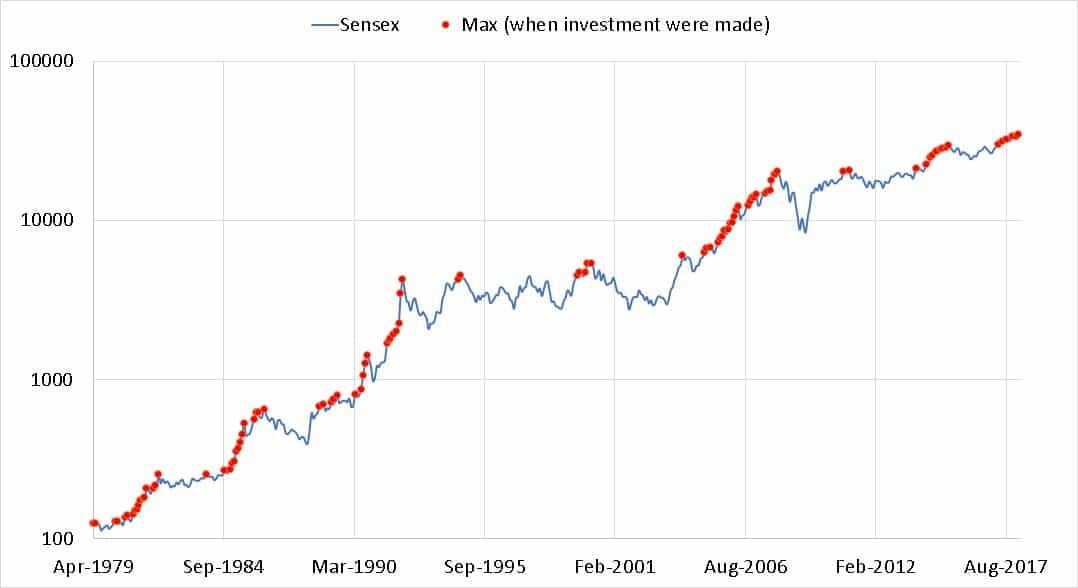
So the red dots represent all-time highs. The Sensex is shown here in log scale. To understand its benefit see: Are you ready to climb the Sensex Staircase?! Thankfully there is only one all-time low – the first couple of data points. So let us not worry about that.
The above graph also visually answers the second part of Pradeep’s comment: Most all-time highs are followed by further all-time highs. So to assume that the market will crash just because there is an all-time high is plain childish.
So now we compare one-shot investing vs gradual investing (over a few months) for different durations for investments made only during all-time highs. I have already shown in the previous study that there is no change in investment risk irrespective of when we invest and how we invest. So I will only show the XIRR(annualized returns) comparison results here.
Ten year investment period: one- shot vs 6 months gradual investment
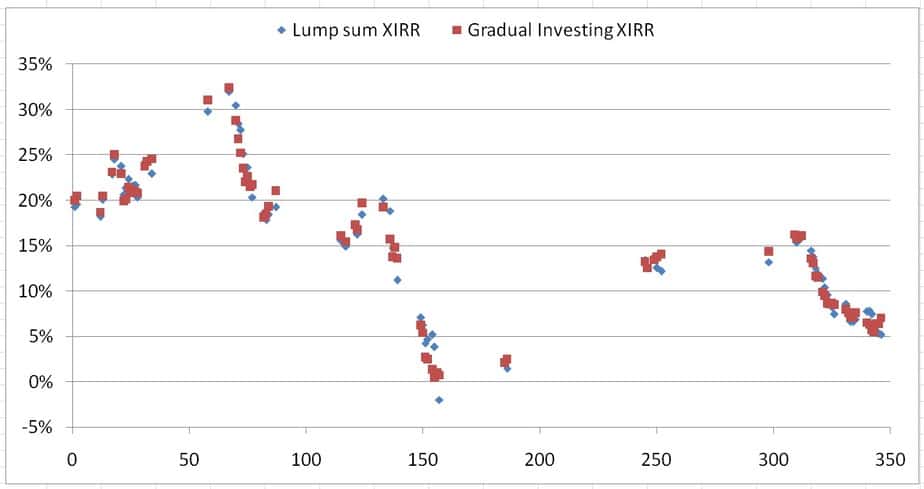
The horizontal axis represents trial no. The gaps imply no investments were made between market-highs. So now, let us plot the return difference between lump sum and gradual investment.
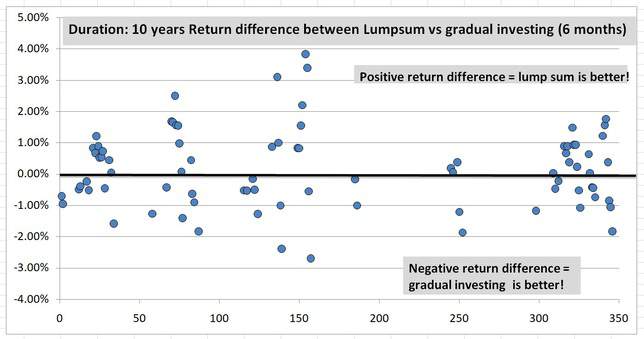
When the return difference is positive (above black horizontal line), one-shot (lump sum) gave better returns. So all points below the black line correspond to when gradual investing was better. It is obvious that there is no clear pattern.
Ten year investment period: one- shot vs 12 months gradual investment
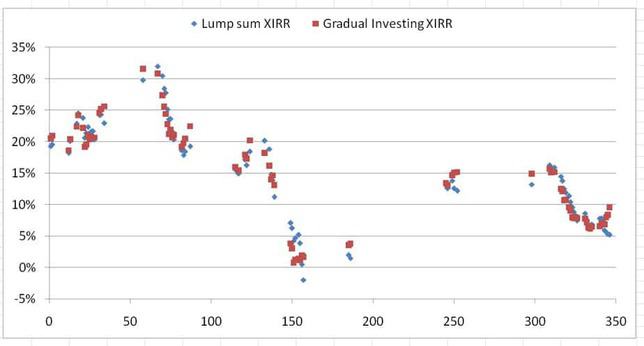
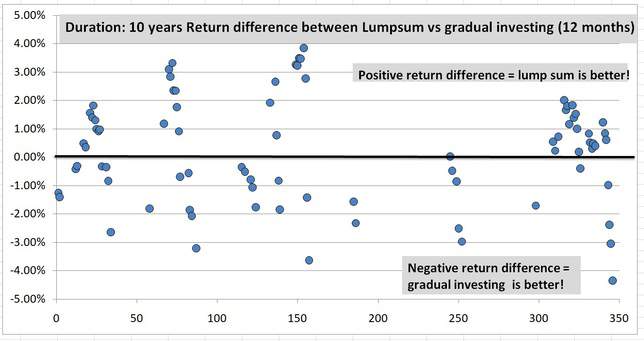
Ten year investment period: one- shot vs 15 months gradual investment
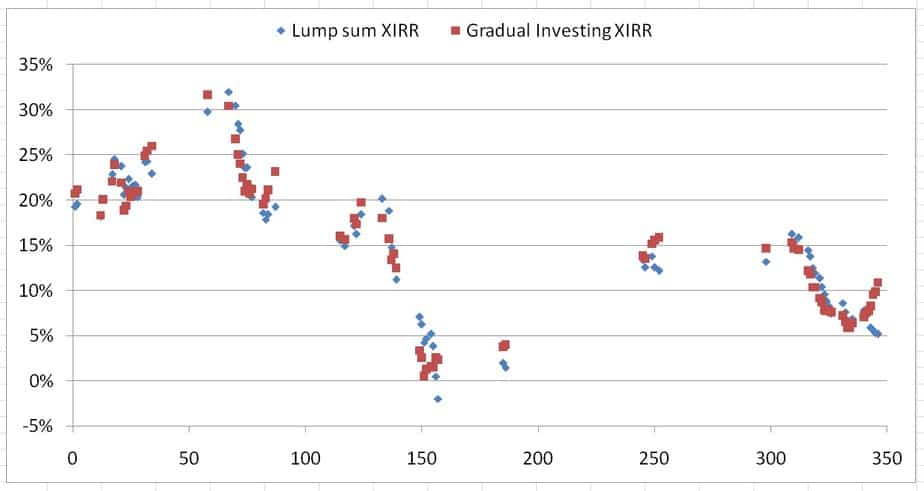
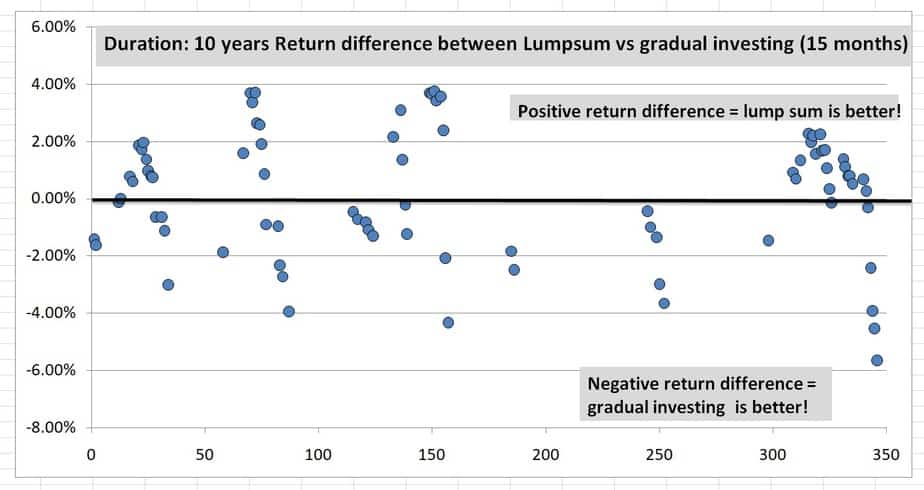
Five year investment period: one- shot vs 6 months gradual investment
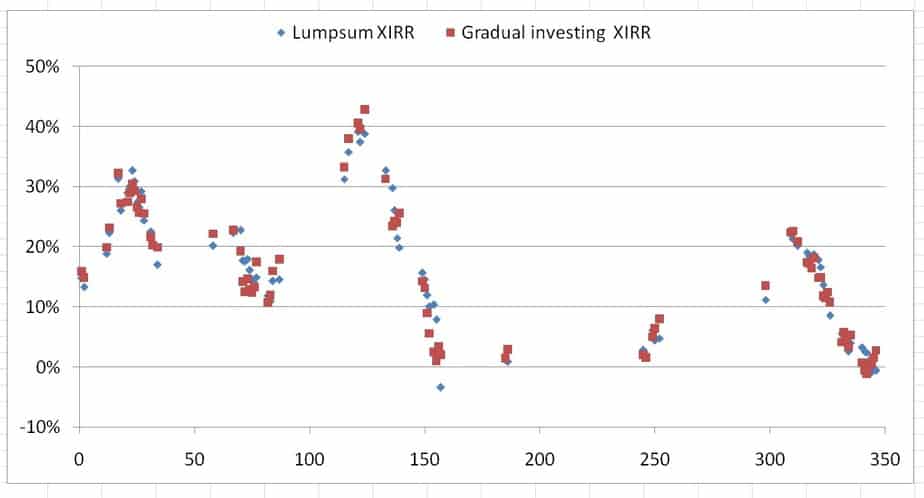
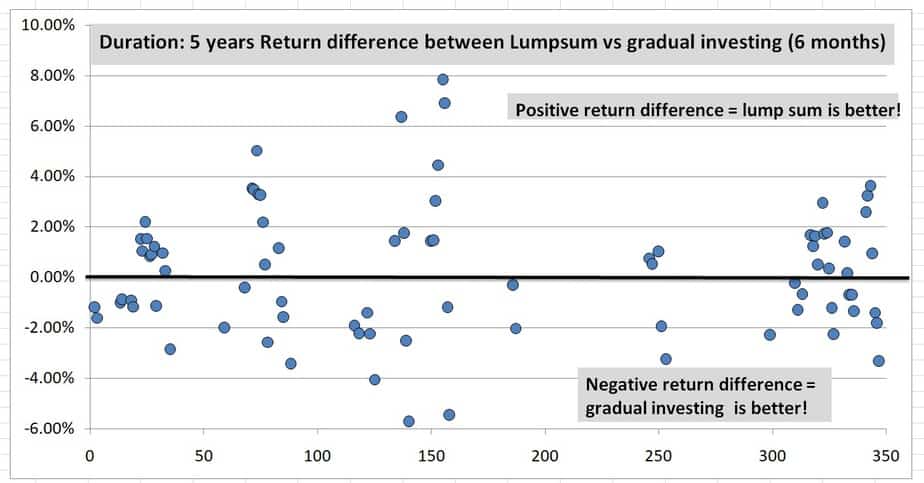
Five year investment period: one- shot vs 12 months gradual investment

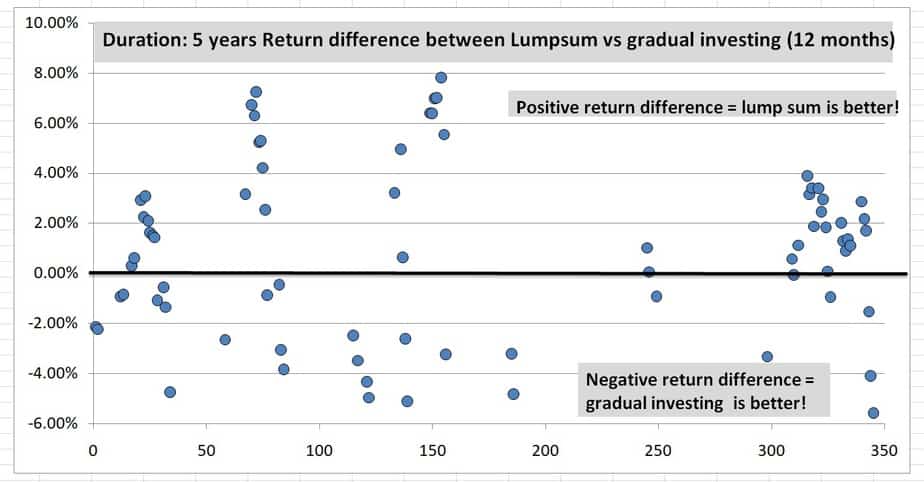
Summary
If the market is at an all-time high and if you have a lump sum, then invest it over a few months and be done with it. This is for your peace of mind. There is no evidence to suggest that gradual investing is better than one-shot investing at all-time highs or at any other time. Please do not assume what appears as common sense to you, will find quantitative support.
🔥Enjoy massive discounts on our courses, robo-advisory tool and exclusive investor circle! 🔥& join our community of 7000+ users!
Use our Robo-advisory Tool for a start-to-finish financial plan! ⇐ More than 2,500 investors and advisors use this!
Track your mutual funds and stock investments with this Google Sheet!
We also publish monthly equity mutual funds, debt and hybrid mutual funds, index funds and ETF screeners and momentum, low-volatility stock screeners.





- Do you have a comment about the above article? Reach out to us on Twitter: @freefincal or @pattufreefincal
- Have a question? Subscribe to our newsletter using the form below.
- Hit 'reply' to any email from us! We do not offer personalized investment advice. We can write a detailed article without mentioning your name if you have a generic question.
Join 32,000+ readers and get free money management solutions delivered to your inbox! Subscribe to get posts via email! (Link takes you to our email sign-up form)
About The Author
 Dr M. Pattabiraman(PhD) is the founder, managing editor and primary author of freefincal. He is an associate professor at the Indian Institute of Technology, Madras. He has over ten years of experience publishing news analysis, research and financial product development. Connect with him via Twitter(X), Linkedin, or YouTube. Pattabiraman has co-authored three print books: (1) You can be rich too with goal-based investing (CNBC TV18) for DIY investors. (2) Gamechanger for young earners. (3) Chinchu Gets a Superpower! for kids. He has also written seven other free e-books on various money management topics. He is a patron and co-founder of “Fee-only India,” an organisation promoting unbiased, commission-free investment advice.
Dr M. Pattabiraman(PhD) is the founder, managing editor and primary author of freefincal. He is an associate professor at the Indian Institute of Technology, Madras. He has over ten years of experience publishing news analysis, research and financial product development. Connect with him via Twitter(X), Linkedin, or YouTube. Pattabiraman has co-authored three print books: (1) You can be rich too with goal-based investing (CNBC TV18) for DIY investors. (2) Gamechanger for young earners. (3) Chinchu Gets a Superpower! for kids. He has also written seven other free e-books on various money management topics. He is a patron and co-founder of “Fee-only India,” an organisation promoting unbiased, commission-free investment advice.Our flagship course! Learn to manage your portfolio like a pro to achieve your goals regardless of market conditions! ⇐ More than 3,000 investors and advisors are part of our exclusive community! Get clarity on how to plan for your goals and achieve the necessary corpus no matter the market condition is!! Watch the first lecture for free! One-time payment! No recurring fees! Life-long access to videos! Reduce fear, uncertainty and doubt while investing! Learn how to plan for your goals before and after retirement with confidence.
Our new course! Increase your income by getting people to pay for your skills! ⇐ More than 700 salaried employees, entrepreneurs and financial advisors are part of our exclusive community! Learn how to get people to pay for your skills! Whether you are a professional or small business owner who wants more clients via online visibility or a salaried person wanting a side income or passive income, we will show you how to achieve this by showcasing your skills and building a community that trusts and pays you! (watch 1st lecture for free). One-time payment! No recurring fees! Life-long access to videos!
Our new book for kids: “Chinchu Gets a Superpower!” is now available!


Must-read book even for adults! This is something that every parent should teach their kids right from their young age. The importance of money management and decision making based on their wants and needs. Very nicely written in simple terms. - Arun.Buy the book: Chinchu gets a superpower for your child!
How to profit from content writing: Our new ebook is for those interested in getting side income via content writing. It is available at a 50% discount for Rs. 500 only!
Do you want to check if the market is overvalued or undervalued? Use our market valuation tool (it will work with any index!), or get the Tactical Buy/Sell timing tool!
We publish monthly mutual fund screeners and momentum, low-volatility stock screeners.
About freefincal & its content policy. Freefincal is a News Media Organization dedicated to providing original analysis, reports, reviews and insights on mutual funds, stocks, investing, retirement and personal finance developments. We do so without conflict of interest and bias. Follow us on Google News. Freefincal serves more than three million readers a year (5 million page views) with articles based only on factual information and detailed analysis by its authors. All statements made will be verified with credible and knowledgeable sources before publication. Freefincal does not publish paid articles, promotions, PR, satire or opinions without data. All opinions will be inferences backed by verifiable, reproducible evidence/data. Contact information: To get in touch, use this contact form. (Sponsored posts or paid collaborations will not be entertained.)
Connect with us on social media
- Twitter @freefincal
- Subscribe to our YouTube Videos
- Posts feed via Feedburner.
Our publications
You Can Be Rich Too with Goal-Based Investing
 Published by CNBC TV18, this book is meant to help you ask the right questions and seek the correct answers, and since it comes with nine online calculators, you can also create custom solutions for your lifestyle! Get it now.
Published by CNBC TV18, this book is meant to help you ask the right questions and seek the correct answers, and since it comes with nine online calculators, you can also create custom solutions for your lifestyle! Get it now.Gamechanger: Forget Startups, Join Corporate & Still Live the Rich Life You Want
 This book is meant for young earners to get their basics right from day one! It will also help you travel to exotic places at a low cost! Get it or gift it to a young earner.
This book is meant for young earners to get their basics right from day one! It will also help you travel to exotic places at a low cost! Get it or gift it to a young earner.Your Ultimate Guide to Travel
 This is an in-depth dive into vacation planning, finding cheap flights, budget accommodation, what to do when travelling, and how travelling slowly is better financially and psychologically, with links to the web pages and hand-holding at every step. Get the pdf for Rs 300 (instant download)
This is an in-depth dive into vacation planning, finding cheap flights, budget accommodation, what to do when travelling, and how travelling slowly is better financially and psychologically, with links to the web pages and hand-holding at every step. Get the pdf for Rs 300 (instant download)